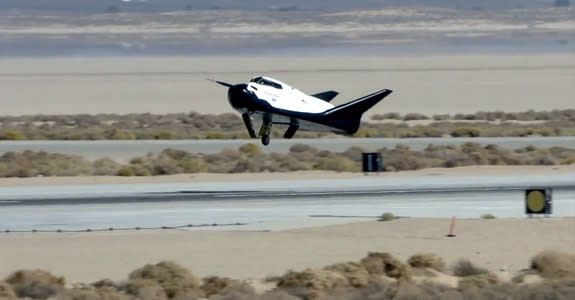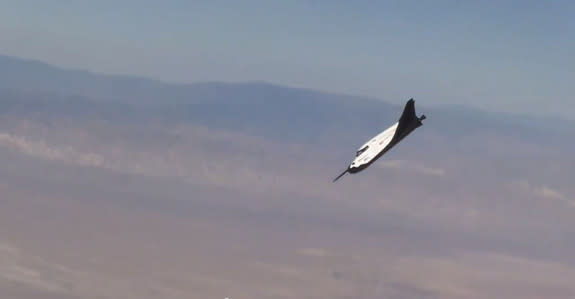Private Dream Chaser Space Plane Skids Off Runway After Milestone Test Flight (Video)
The first free flight of a new private space plane successfully tested the spacecraft's automated approach and landing system, despite a malfunction that sent the spacecraft skidding off the runway at the end of the flight, its builder tells SPACE.com.
The Dream Chaser space plane, constructed by Sierra Nevada Corporation, was hoisted by helicopter high above Edwards Air Force Base in California on Saturday (October 26), then let loose to glide down to a tarmac touchdown. The unmanned flight test, a major step for the project, was performed in conjunction with NASA's Dryden Flight Research Center at the Edwards Air Force Base. Sierra Nevada officials released a video of the Dream Chaser drop test which shows the landing gear malfunction, but the video ends before the craft touches down on its runway.
"We had a successful approach to the runway. The vehicle flared on cue and the speeds were perfect," said Mark Sirangelo, corporate vice president and head of Sierra Nevada Corporation’s (SNC) Space Systems based in Louisville, Colo. [Photos of Dream Chaser, America's New Space Plane]
"We hit the centerline exactly where we needed to be. On approach and landing, the left main gear did not deploy satisfactorily," Sirangelo told SPACE.com. "Something hung up on the gear and it didn't deploy."
A walk-away landing incident
The Dream Chaser space plane resembles a miniature space shuttle, and is being developed to carry astronauts to and from the International Space Station, and other destinations in low-Earth orbit. The seven-passenger vehicle is about 29.5 feet (9 m) long and has a wingspan of 22.9 feet (7 m). [Dream Chaser Space Plane Explained (Infographic)]
The landing gear malfunction during the Saturday drop test sent the Dream Chaser prototype skidding off the runway, Sirangelo said.
"It exited off the runway fairly quickly a few seconds after the one landing gear failed to come down," Sirangelo said.
As for damage, Sirangelo said that the space plane's pressure vessel — which would house the crew cabin — was not damaged, with onboard computers still working even after the skid to a full stop.
"The crew compartment was completely intact," and pilots would have walked away from the landing incident, Sirangelo said. "We found out how tough the vehicle really was. Everything inside the vehicle is completely the way it was," in pre-drop condition, he added.
A mishap investigation team is being formed to look into the problem, Sirangelo said.
"Unofficially, it looks like the gear door didn't open properly … so the gear couldn't come down all the way."
The Dream Chaser "got beat up a bit," Sirangelo said, but came to rest on its normal horizontal position on its main landing skids. "It's not in pieces. It's going to be flyable again."
Dream Chaser's first drop test
Previously, SNC engineers had put the Dream Chaser prototype through a series of ground and captive-carry tests to set the stage for the unpiloted approach-and-landing test flight.
Sirangelo said he was in a mission control room for the Dream Chaser free-flight and all systems were green, with the weather perfect. The space plane followed an identical flight profile as it would carry out on return from Earth orbit, he said.
The Dream Chaser was dropped by a helicopter from a height of 12,500 feet entered into its pre-planned dive to pick up speed, working its flight control surfaces while en route to the runway.
After helicopter release, the space plane pointed down to the ground to gain velocity before pulling up, admittedly a heart-pounding moment, Sirangelo said.
"It autonomously pulled out on cue and began to fly itself down," Sirangelo said, with the flight control software operating in top-notch form and flew the craft to the center line of the runway.
"We met all the test parameters. We got even better data than we expected … and more of it," Sirangelo said. "We were mostly worried about the flight conditions. How it would fly … worried about would the software and the flight controls all work. And then we worried about would the craft approach and land properly. And all those things worked perfectly."
Orbital flight vehicle work under way
The Dream Chaser design is derived from NASA's HL-20 lifting body that had years of development, analysis, and wind tunnel testing at the space agency's Langley Research Center in Virginia.
Sirangelo said that simulating flight of the Dream Chaser on the ground is one thing. "But Mother Nature does wacky things. Until you actually fly you just never know."
For the present, what's ahead is to make sure all the data needed has been collected. Also to be appraised is what it's going to take to get the vehicle flying again, Sirangelo said.
"We only expected to have two flights on this vehicle anyway, before we brought it back to Colorado," Sirangelo said. "We collected enough data that we might not need a second flight. We'll see when we get all the data sorted out."
Sirangelo said that construction of an orbital flight vehicle, in partnership with Lockheed Martin, is already underway.
Sierra Nevada is one of three space firms, along with SpaceX and Boeing, to receive funding from NASA's commercial crew program, which aims to foster the development of new spacecraft to replace the agency’s space shuttles, which were retired in 2011.
SpaceX and Boeing are both designing capsules, and Dream Chaser is the only reusable winged spacecraft being developed under NASA’s commercial crew program. NASA hopes at least one of the new vehicles will fly by 2017.
Leonard David has been reporting on the space industry for more than five decades. He is former director of research for the National Commission on Space and is co-author of Buzz Aldrin's new book "Mission to Mars – My Vision for Space Exploration" published by National Geographic. Follow us @Spacedotcom, Facebook and Google+. Original article on SPACE.com.
Copyright 2013 SPACE.com, a TechMediaNetwork company. All rights reserved. This material may not be published, broadcast, rewritten or redistributed.




